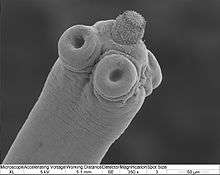Rostellum (helminth)
Rostellum /ˌrɑːˈstɛlʌm/ (meaning "small beak", from the Latin rostrum for "beak"; pl. rostella) in helminthology is a protruding part of the anterior end of tapeworms. It is a retractable, cone-like muscular structure that is located on the apical end of the scolex, and in most species is armed with hooks, the organs of attachment to the host's intestinal wall.[1] It is a parasitic adaptation in some cestodes for firm attachment in the gastrointestinal tract and is structurally different from one species to another (or even absent is some species), thereby becoming an important diagnostic feature.[2][3]

Structure

A rostellum is a knob-like protrusion at the extreme anterior end of a tapeworm, as an extension of the tegument. It is globular, spiny structure when it protrudes, and a circular hollow pit when retracted. It is structurally composed of a number of concentric rows of hooks. The number and arrangement of the hooks are species specific. The two basic types of hooks are those of the upper row, which are larger and had a projecting, rounded stout guard, and those of the lower row, which are smaller and have a flattened guard.[4] At the base, the hooks gradually resemble the general body hairs or microtriches. This shows that the hooks are modified microtriches. Electron-dense hook substance is deposited along the edges of the microthrix to form the hook blade and basal plate. The blade may be hollow or solid depending on the species. The base is connected to the underlying cytoplasm.[5][6][7] Rostellum is innervated by a single bilateral pair of ganglia, which provide motor innervation of the anterior canal, and the circular muscles of the rostellar capsule; this connection controls the protrusion and retraction movements. The tegument lining the anterior canal and covering the apical rostellum is syncytial and continuous with the tegument of the scolex proper.[8]
Function
The rostellum is an organ of attachment of tapeworms, in addition to the surrounding suckers, to the intestinal wall of the host. It is protruded during attachment, and by the use of hooks penetrates the intestinal mucosa. This is particularly important during digestion of food and bowel movement of the host, so that the tapeworm is not expelled along with the faeces.[9]
References
- Castro GA (1996). "Helminths: Structure, Classification, Growth, and Development". In Baron S (ed.). Medical Microbiology (4 ed.). Galveston (TX): University of Texas Medical Branch at Galveston. ISBN 978-0-9631172-1-2. PMID 21413252.
- Spasskii AA, Buga ML (2000). "Correlation between the structure of the rostellar apparatus and the shape of rostellar hooks in higher cestodes". Doklady Biological Sciences. 372: 290–292. PMID 10944726.
- Vasileva GP, Vaucher C, Tkach VV, Genov T (2004). "Taxonomic revision of Hilmylepis Skryabin & Matevosyan, 1942 (Cyclophyllidea: Hymenolepididae)". Systematic Parasitology. 59 (1): 45–63. doi:10.1023/b:sypa.0000038446.29832.7d. PMID 15318020.
- Antoniou M, Tselentis Y (1993). "Studies on Echinococcus granulosus using the scanning electron microscope. II. The hooks". Parasitology Research. 79 (7): 543–546. doi:10.1007/bf00932237. PMID 8278335.
- Fourie HJ, Van Amelsfoort AF, Michael LM, Putterill JF (1997). "A scanning electron-microscope examination of the scolex of Houttuynia struthionis". Onderstepoort Journal of Veterinary Research. 64 (1): 47–50. PMID 9204503.
- Fan PC, Lin CY, Chen CC, Chung WC (1995). "Morphological description of Taenia saginata asiatica (Cyclophyllidea: Taeniidae) from man in Asia". Journal of Helminthology. 69 (4): 299–303. doi:10.1017/S0022149X00014863. PMID 8583124.
- Zd'árská Z, Nebesárová J (2003). "Ultrastructure of the early rostellum of Silurotaenia siluri (Batsch, 1786) (Cestoda: Proteocephalidae)". Parasitology Research. 89 (6): 495–500. doi:10.1007/s00436-002-0800-7. PMID 12658462.
- Specian RD, Lumsden RD (1980). "The microanatomy and fine structure of the rostellum of Hymenolepis diminuta". Zeitschrift für Parasitenkunde. 63 (1): 71–88. doi:10.1007/bf00927728. PMID 7415422.
- Merchant MT, Aguilar L, Avila G, Robert L, Flisser A, Willms K (1988). "Taenia solium: description of the intestinal implantation sites in experimental hamster infections". Journal of Parasitology. 84 (4): 681–685. doi:10.2307/3284569. JSTOR 3284569. PMID 9714193.